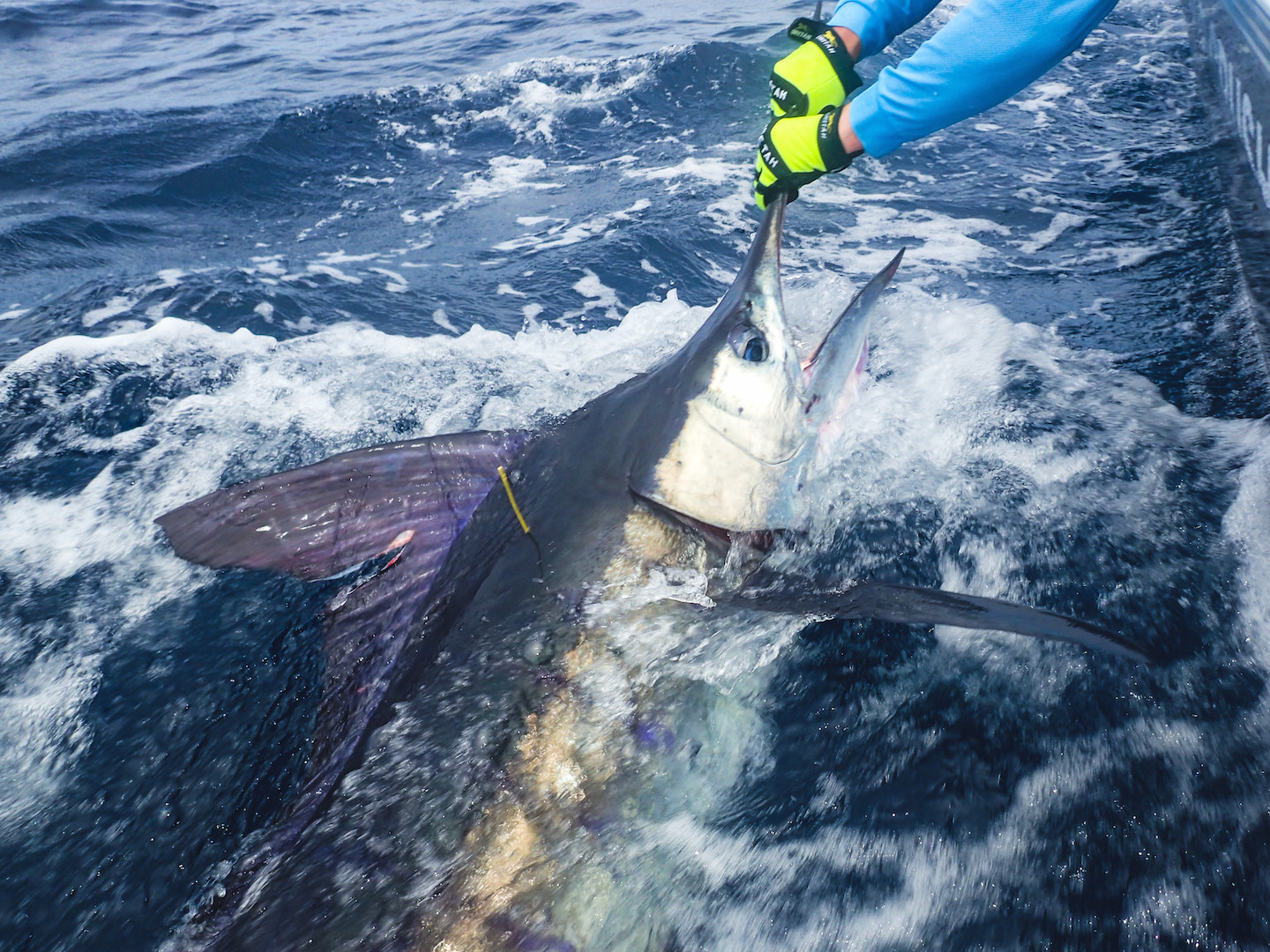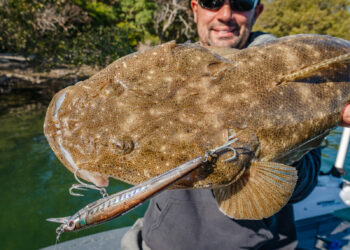
STRIPED marlin (Kajikia audax) are widely considered to be the most hotly contested of the billfish species. This is because, as the best eating of the billfish, they are heavily targeted by the commercial longlining sector in many parts of their range (which includes both the Pacific and Indian Oceans) for lucrative sashimi markets. However, striped marlin are also an exciting gamefish which form the basis of economically important recreational fisheries in many places throughout the world, including Australia.
Taxonomically, amongst the billfishes the striped marlin is most closely related to the Atlantic white marlin (Kajikia albida). Until relatively recently, both these species were grouped together with the spearfishes in the genus Tetrapturus, however in 2006 a study published in the Bulletin of Marine Science used genetic and other evidence to separate both the “medium sized” marlins (white and striped) into the genus Kajikia, leaving the smaller spearfishes in Tetrapturus. Striped marlin are an exclusively oceanic species which usually occur on or beyond the continental shelf in tropical and warm temperate waters, only being seen close to shore where deep drop-offs occur near islands, seamounts and boundary currents which concentrate their prey (which consists of a wide variety of fishes, crustaceans, and squids). This species generally inhabits cooler waters compared to black or blue marlin, with the distinctive stripies being easily distinguished from their larger cousins by the 20 or so conspicuous cobalt blue to luminescent vertical stripes or bands along their sides. Because of the economic importance of striped marlin for both commercial and recreational fishing, a large amount of research effort has been expended to learn more about them, particularly over the past 20 years. Let’s explore some of the outcomes from this work.
As far as billfish go, striped marlin are only medium sized, reaching a maximum length including the bill of around 4.2 meters (equating to a lower-jaw to fork length (LJFL) of around 3.4 meters), and weights around 240 kg/500 pounds. However, studies of daily growth increments (determined by sectioning fin spines and otoliths) of striped marlin from the south west Pacific Ocean have shown they are amongst the fastest growing of all fishes. Spawning occurs offshore above the thermocline in tropical equatorial areas in both the Indian and Pacific Oceans wherever water temperatures exceed 24°C. Under suitable conditions spawning in mature females occurs every couple of days in batches of several million eggs around 1mm diameter, with up to 40+ spawning events each season (equating to around 120+ million eggs per 100kg female per season). The larvae and juveniles are voracious predators which grow extremely rapidly to over 100cm LJFL and a body weight of 4-5kg within 4 months, 150cm LJFL (c. 18kg) in 8 months, and 170-180cm LJFL (c. 30-40kg) in the first 12 months in the waters off Australia and New Zealand. Maturity occurs in the second year of growth and sex-specific differences in growth rates are apparent, with male fish maturing slightly earlier (1-2 years old) and at a smaller size (150-180cm LJFL) than females (1.5-2.5 years old, 170-220cm LJFL). Indeed, like many other fish species, the females ultimately grow to a larger size (3 + meters LJFL vs 2.5 meters LJFL for males) and greater age (over 10 years and possibly up to 12 years vs a maximum of 7-8 years for males) in the south west Pacific Ocean. These growth rates are not uniform throughout the range of the species though, as there are at least 5 different stocks of striped marlin, one in the Indian Ocean, one off eastern Australia and New Zealand, one centred in Hawaii, and two in the eastern tropical Pacific. Region-specific variations in growth rates occur, probably due to variations in local conditions including their food supply.
Various tagging studies over the years have revealed a lot of interesting data on the movements of striped marlin, but most of this information has been very hard won. It turns out that tagging of billfish in general, and striped marlin in particular, is very difficult due to extremely high rates of tag shedding. This was fully realised after a recently published study (undertaken off Baja California on Mexico’s west coast since 2008) by Michael Domeier and colleagues from the Marine Conservation Science Institute Hawaii, which reported a very high tag recovery rate (exceeding 10%) for striped marlin which were tagged with archival tags surgically implanted into the abdominal cavity. This contrasted markedly with the very low (c. 1.3%) tag return rates historically achieved for striped marlin using the externally applied conventional dart tags traditionally used by researchers and recreational gamefishers worldwide since the 1950’s (comparable to the c. 0.9% return rate for >27000 striped marlin tagged by the NSW gamefish tagging program since 1974). The authors of the archival tag study also tagged each fish with conventional tags, but none of these remained even though the archival tags were recovered between 400 days and 7.7 years after tagging. This suggested that all of the external tags dropped out within the first year, indicating that the cause of very poor conventional tag returns in marlins is not because of high mortality rates or under-reporting, but instead due to very high rates of tag shedding.
While the surgical implantation of archival tags solved the shedding problem, the sensor stalks of 100% of the archival tags failed after 32 to 286 days, reducing the information gathered by these devices and showing the severity of the rough and tumble environment that is a tagged striped marlin. Water intrusion from the broken sensor stalks also killed off the pressure sensors for most of the tags, however fortunately the pressure sensor remained functional on the one fish that was recaptured after 7.7 years. The data showed that fish (174 cm LJFL and c. 18 months old when tagged) had dived to a maximum depth of 352 meters, which is below the thermocline where water temperatures had dropped to 10°C. Interestingly, the fish (which was probably more than 9 years old when recaptured), had shown hardly any growth in the 7.7 years at liberty, showing the striped marlin around Baja California have markedly different growth characteristics compared to the population of fish around Australia and New Zealand.
Several studies utilising “pop up” satellite tags have also been undertaken on striped marlin populations from many different parts of their range. While these studies have all suffered to varying degrees from the same tag shedding issues as conventional tagging (maximum time at liberty for a pop up satellite tag on a striped marlin was quoted as only 259 days), because pop up satellite tags can still provide data “on the run” by uploading their data when they float to the surface after they are shed from the fish, these studies have generated some very interesting horizontal movement data which has confirmed beyond doubt the striped marlins “highly migratory” status. Pop-up tagging studies along Australia’s east coast and in northern New Zealand confirm that striped marlin can swim from the Coral Sea to Tasmania within a season (their presence in the more southern latitudes occurring during the summer months), with average movements of around 50 km per day. One fish swam from New Zealand to New Caledonia over 2000 km away, before returning to within 400 km of its original tagging location 8 months later.
Tracking of a typical striped marlin using a pop up satellite tag indicates they spend most of their time above the thermocline and nearly 70-90+ % of their time in the top 5 meters of water. Off south east Australia and New Zealand during the summer months, temperature data indicate around 75 per cent of a striped marlin’s time may be spent near oceanic fronts in water temperatures between 20°C and 24°C, while striped marlin tagged near the equator in the western Indian Ocean off Kenya spend most of their time in surface waters between 28- and 30°C. Like off Australia, the striped marlin off the east coast of Africa were highly mobile, covering horizontal distances of up to 9,187km over periods ranging up to 183 days, with a mean daily distance travelled of around 48km, though they covered a much reduced distance during the night (averaging less than 2km per night).
On a global basis, striped marlin are considered by the IUCN as “Near Threatened” and their stock in the Indian Ocean was last assessed as “overfished and subject to overfishing”. Commercial fisheries for this species in the north west Pacific and Indian Oceans are not considered to be well managed. Around Australia we are also seeing striped marlin populations in the Eastern Tuna and Billfish Fishery now being classified as “overfished”, while those on the west coast are considered both overfished and “subject to overfishing”. However, economic studies conducted in NSW around 15 years ago found a striped marlin caught by the recreational sector (who release around 80-90% of their catch) was worth over 7 times the economic “bang for your buck” generated by a similar fish taken by the commercial fishery. Go figure.


















